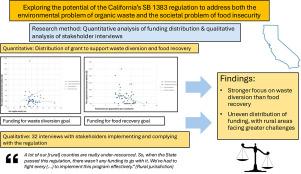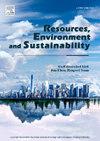转移还是捐赠?加州尝试减少有机废物和食品不安全的早期经验
IF 7.8
Q1 ENVIRONMENTAL SCIENCES
引用次数: 0
摘要
食物浪费构成了重大的环境和社会挑战,据估计,全球30%的粮食产量在供应链上损失或浪费,对环境可持续性和粮食安全构成威胁。联合国可持续发展目标12.3旨在到2030年将全球食物浪费减半,将减少浪费与缓解饥饿联系起来。加州试图通过参议院1383号法案(一项新的有机废物法)同时解决这两个优先事项。本文通过研究sb1383的双重目标之间的紧张关系,为减轻粮食损失和浪费(FLW)的文献做出贡献:从垃圾填埋场转移有机废物,并将剩余粮食重新分配给有需要的社区。虽然sb1383是一项进步的政策,但它的实施暴露了这些目标之间的冲突。我们评估SB 1383对利益相关者遵守其减少食物浪费和回收要求的影响。具体来说,我们研究了该法规的两个关键目标:(1)通过从垃圾填埋场转移有机废物来缓解气候变化;(2)通过将回收的食物重新分配给有需要的社区来解决粮食不安全问题。我们采访了37个利益相关者,包括参与实施的食品回收组织、司法管辖区代表和食用食品生产商。此外,我们还分析了加州各县的地方援助补助金的分配情况,以及该政策的双重目标之间的分配情况。我们的研究结果表明,废物转移比食物回收更受重视,而且资金分配不均,农村地区在适应SB 1383的要求方面面临更大的挑战。最后,我们强调了FLW政策设计中的紧张关系,这种紧张关系寻求推进多个(有时是相互竞争的)目标。本文章由计算机程序翻译,如有差异,请以英文原文为准。

Divert or donate? Early experiences with California’s attempt to reduce organic waste and food insecurity
Food waste poses significant environmental and societal challenges, with an estimated 30% of global food production lost or wasted along the supply chain, threatening both environmental sustainability and food security. The United Nations’ Sustainable Development Goal 12.3 aims to halve global food waste by 2030, linking waste reduction to hunger alleviation. California sought to address both priorities simultaneously through Senate Bill (SB) 1383, a novel organic waste law. This article contributes to the literature on food loss and waste (FLW) mitigation by examining tensions between SB 1383’s dual goals: diverting organic waste from landfills and redistributing surplus food to communities in need. While SB 1383 is a progressive policy, its implementation has revealed conflicts between these objectives. We assess the impact of SB 1383 on stakeholder compliance with its food waste reduction and recovery requirements. Specifically, we examine the two key objectives of this regulation: (1) mitigating climate change by diverting organic waste from landfills, and (2) addressing food insecurity by redistributing recovered food to communities in need. We interviewed 37 stakeholders, including food recovery organizations, jurisdiction representatives, and edible food generators involved in implementation. Additionally, we analyzed the distribution of Local Assistance Grant funds across California counties and between the policy’s dual goals. Our findings indicate a stronger focus on waste diversion than food recovery, and an uneven distribution of funding, with rural areas facing greater challenges in adapting to SB 1383’s requirements. We conclude by highlighting tensions in FLW policy design that seeks to advance multiple, sometimes competing, goals.
求助全文
通过发布文献求助,成功后即可免费获取论文全文。
去求助
来源期刊

Resources Environment and Sustainability
Environmental Science-Environmental Science (miscellaneous)
CiteScore
15.10
自引率
0.00%
发文量
41
审稿时长
33 days
 求助内容:
求助内容: 应助结果提醒方式:
应助结果提醒方式:


